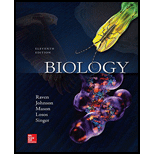
Concept explainers
The Miller-Urey experiment demonstrated that
a. life originated on Earth.
b. organic molecules could have originated in the early atmosphere.
c. the early genetic material on the planet was DNA.
d. the early atmosphere contained large amounts of oxygen.
Introduction:
Stanley Miller and Harold Urey performed an experiment that showed the organic compounds were formed by the stimulation of the early atmosphere of the Earth. Earlier the atmosphere of the Earth was reducing in nature due to the absence of oxygen and the presence of large amounts of hydrogen. Miller and Urey performed their experiments in reducing the environment and check the chemical origin of life under a reducing environment. They found that the reducing environment of the Earth favored more to the formation of organic molecules from the inorganic substances which are present at that time.
Answer to Problem 1U
Correct answer:
The Miller‑Urey experiment showed that the organic molecules could have originated in the early atmosphere. Therefore, option b. is correct.
Explanation of Solution
Reason for the correct statement:
Miller and Urey created an artificial environment in the laboratory which was very similar to the early Earth atmosphere (reducing environment). Their experiment shows that only the organic complex molecules are formed from the inorganic molecules due to the presence of reducing molecules in the environment.
Option b. is given as “organic molecules could have originated in the early atmosphere”.
As “Miller and Urey demonstrated that the organic molecules could have originated in the early atmosphere,” it is the right answer.
Hence, option b. is correct.
Reasons for the incorrect statements:
Option a. is given as “life originated on earth”.
Miller and Urey demonstrated the chemical evolution on the Earth. They could not demonstrate the biological evolution on the Earth. Hence, it is the wrong answer.
Option c. is given as “the early genetic material on the planet was DNA”.
Miller and Urey demonstrated that the organic molecules evolved due to the reducing environment. They could not show that DNA was the earliest genetic material. Hence, it is the wrong answer.
Option d. is given as “the early atmosphere contained large amounts of oxygen”.
The Miller and Urey experiment demonstrated that the earlier nature of the atmosphere of the Earth was reducing in nature due to the absence of oxygen. Hence, it is the wrong answer.
Hence, options a., c. and d. are incorrect.
Conclusion:
Miller and Urey showed that the organic complex molecules were formed due to the presence of reducing molecules in the early atmosphere.
Want to see more full solutions like this?
Chapter 26 Solutions
Biology
- Q8. A researcher wants to study the effectiveness of a pill intended to reduce stomach heartburn in pregnant women. The researcher chooses randomly 400 women to participate in this experiment for 9 months of their pregnancy period. They all need to have the same diet. The researcher designs two groups of 200 participants: One group take the real medication intended to reduce heartburn, while the other group take placebo medication. In this study what are: Independent variable: Dependent variable: Control variable: Experimental group: " Control group: If the participants do not know who is consuming the real pills and who is consuming the sugar pills. This study is It happens that 40% of the participants do not find the treatment helpful and drop out after 6 months. The researcher throws out the data from subjects that drop out. What type of bias is there in this study? If the company who makes the medication funds this research, what type of bias might exist in this research work?arrow_forwardHow do I determine the inhertiance pattern from the pedigree diagram?arrow_forwardits an open book assignemntarrow_forward
- Describe two different gene regulation mechanisms involving methylationarrow_forwardWhat is behavioral adaptarrow_forward22. Which of the following mutant proteins is expected to have a dominant negative effect when over- expressed in normal cells? a. mutant PI3-kinase that lacks the SH2 domain but retains the kinase function b. mutant Grb2 protein that cannot bind to RTK c. mutant RTK that lacks the extracellular domain d. mutant PDK that has the PH domain but lost the kinase function e. all of the abovearrow_forward

 Concepts of BiologyBiologyISBN:9781938168116Author:Samantha Fowler, Rebecca Roush, James WisePublisher:OpenStax College
Concepts of BiologyBiologyISBN:9781938168116Author:Samantha Fowler, Rebecca Roush, James WisePublisher:OpenStax College Human Biology (MindTap Course List)BiologyISBN:9781305112100Author:Cecie Starr, Beverly McMillanPublisher:Cengage Learning
Human Biology (MindTap Course List)BiologyISBN:9781305112100Author:Cecie Starr, Beverly McMillanPublisher:Cengage Learning Biology (MindTap Course List)BiologyISBN:9781337392938Author:Eldra Solomon, Charles Martin, Diana W. Martin, Linda R. BergPublisher:Cengage Learning
Biology (MindTap Course List)BiologyISBN:9781337392938Author:Eldra Solomon, Charles Martin, Diana W. Martin, Linda R. BergPublisher:Cengage Learning Biology: The Dynamic Science (MindTap Course List)BiologyISBN:9781305389892Author:Peter J. Russell, Paul E. Hertz, Beverly McMillanPublisher:Cengage Learning
Biology: The Dynamic Science (MindTap Course List)BiologyISBN:9781305389892Author:Peter J. Russell, Paul E. Hertz, Beverly McMillanPublisher:Cengage Learning Biology Today and Tomorrow without Physiology (Mi...BiologyISBN:9781305117396Author:Cecie Starr, Christine Evers, Lisa StarrPublisher:Cengage Learning
Biology Today and Tomorrow without Physiology (Mi...BiologyISBN:9781305117396Author:Cecie Starr, Christine Evers, Lisa StarrPublisher:Cengage Learning





